Most people who are into health and fitness love almond butter. This delicious alternative to peanut butter is filling, and full of protein, healthy fats, and antioxidants. But there is a new challenger in town, it’s called Tahini.
Which one will come out on top, Tahini or Almond Butter?
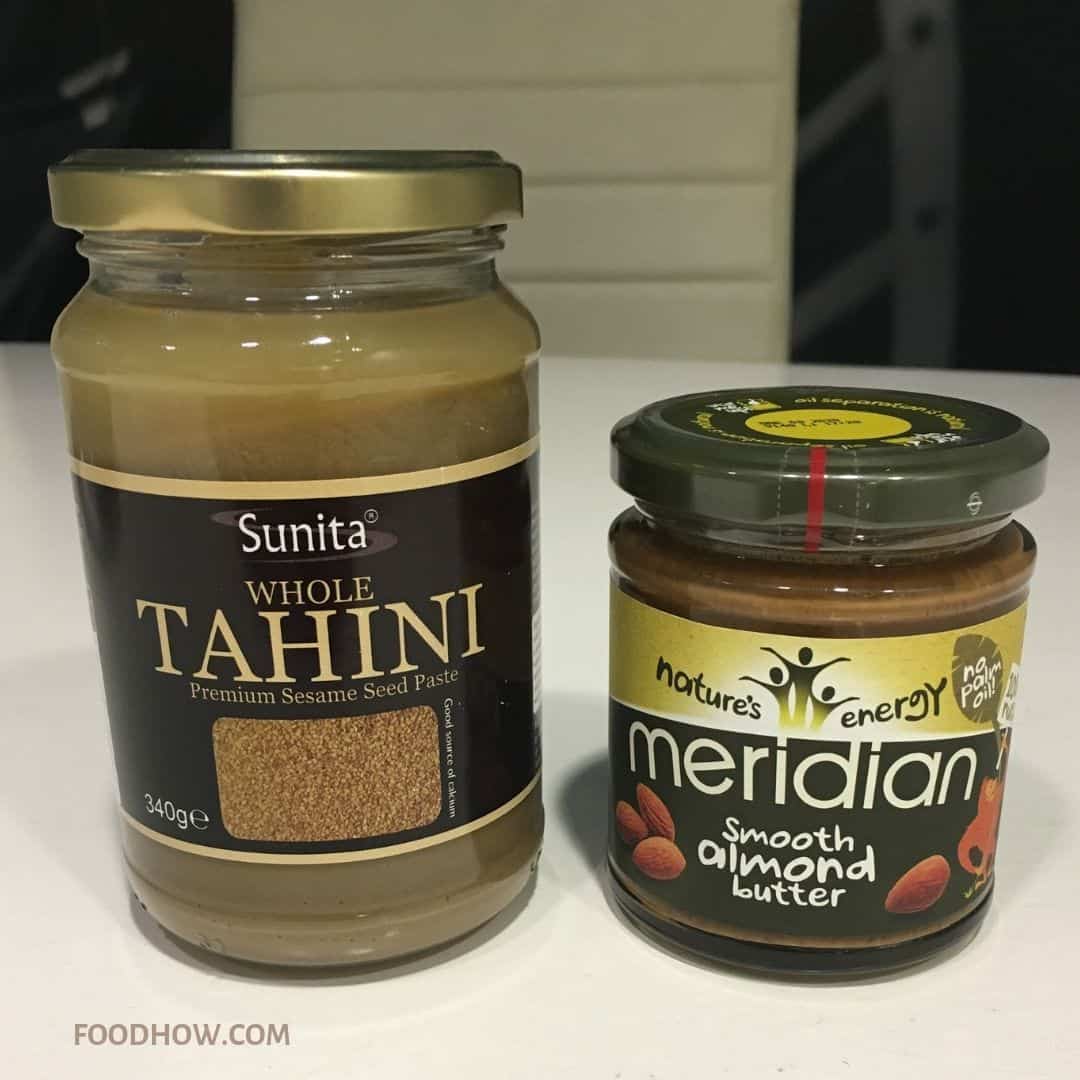
It isn’t surprising when you see different expressions on people’s faces when you ask, “Do you know what Tahini is?” The expressions range from being surprised to be confused or the usual “I don’t know” expression.
If you had any of these expressions when you first heard the word “Tahini,” don’t worry, you’re still human and on planet Earth.
For the curious ones, Tahini will be explained as well as why you should consider including it in your diet.
I will also compare Thaini to other popular butter-like Almond and Peanut butter and see if it could, should be used to substitute these.
Full of wholesome nutrients, a staple in Middle Eastern and Mediterranean cuisine, and the ideal ingredient to trickle on everything, Tahini is the hot new trend to watch!
Check Out My Favorite Stone-Ground Sesame Tahini Paste Below.
What Is Tahini?

Tahini is a butter-like paste made from ground-roasted sesame seeds and is a delicacy added to many ethnic cuisines. It’s common in different parts of the world like North Africa, Greece, Iran, Turkey, and the Middle East. It’s made from ground hulled sesame seeds which are toasted over the fire.
While it can make a tasty dip for a whole lot of things, it’s often used as a major ingredient in hummus, baba ghanoush, and halva.
Sesame seeds have a very high protein content, similar to other nuts or seeds, making them popular high-protein food.
Tahini also contains linoleic acid, oleic fatty acid, phenolic compounds, tryptophan, methionine, lysine, gamma-tocopherol, and amino acids.
Great news for vegans! It’s vegan, gluten-free, and has a lovely taste while being very easy to make.
Store-bought Tahinis are made using hulled sesame seeds. Unhulled and sprouted sesame seeds can also be used. The difference between the two is noticeable in the taste and texture. The hulled-sesame-made one tastes sweeter and has a smoother texture than the unhulled-sesame-made Tahini.
Ways To Use Tahini

Tahini is great to use when making hummus. There are also so many other ways to use Tahini, and below are a few more ideas for you. You can also create your own special recipe.
- Use it as a sauce for your vegetables and meat.
- Add it to your dessert.
- Make your own tahini salad dressing.
- Make Baba Ganoush (delicious roasted eggplant dip).
- Add it to smoothies with the fruits of your choice.
- Use it in your soup. Carrot soup with Tahini will taste really great.
- Tahini in the fridge can last over a month, and that’s enough time to try it with a variety of dishes.
- Make a salad dressing by mixing water and lemon juice with 2 tbsp of sesame seed butter.
Tahini is delicious with both savory and sweet dishes and is as adaptable as almond butter.
How To Make Tahini At Home?
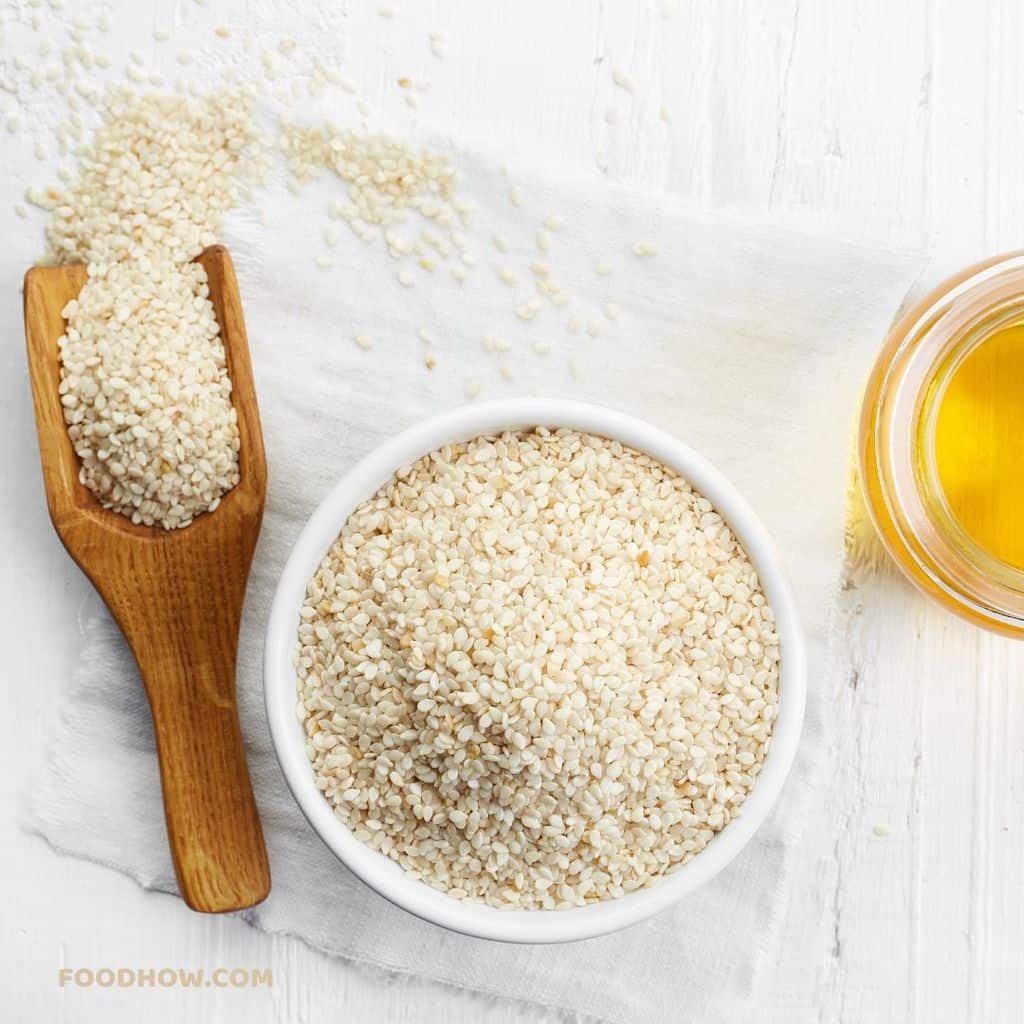
Tahini can be made in different ways, but here is my favorite and really easy way of making it at home.
When making Tahini, you’ll need three ingredients.
- Sesame seeds: hulled sesame seeds taste better than unhulled, so if you don’t want your Tahini the be quite bitter, you should use hulled.
- Oil: it’s used to help turn sesame seeds into a creamy and smooth paste. You can use grapeseed oil, olive oil, canola, or even vegetable oil.
- Salt is an optional ingredient, but it does enhance the taste.
Easy Tahini Recipe
Making it at home is easy and less expensive than the one bought at stores. You can buy bulk sesame seeds online. I mostly use my food processor for making Tahini, but you can use a high-powered blender too.
My homemade recipe should give you a 1-2 cup of Tahini.
Ingredients
- 1 cup (5 ounces or 140 grams) sesame seeds, we prefer hulled.
- 2 to 4 tablespoons of oil such as grapeseed, canola, or olive oil.
- A pinch of salt (optional).
Procedure
- Toast the sesame seeds.
- Add the sesame seeds to a dry saucepan over medium-low heat and toast.
- Stir constantly until the seeds get a strong aroma while being very lightly colored (not brown). Stir 3-5 minutes. Be careful to avoid the sesame seeds getting burnt.
- Transfer the toasted seeds to a baking sheet or large plate and let it cool.
- Add sesame seeds to the bowl of a food processor then process until it forms a crumbly paste. Then process for 1 minute.
- Add 3 tablespoons of your chosen oil then process for 2 to 3 minutes more.
- Stop at intervals to scrape the bottom and sides of the food processor a couple of times.
- Check the Tahini. It should be smooth, not gritty, and you should be able to easily pour it out.
- You may need to process it for another minute or add the additional tablespoon of oil till it gets the required smooth texture.
- Taste it for seasoning then add salt to taste.
- Process 5 to 10 seconds more to mix it in.
Don’t be alarmed when the oil in Tahini separates during storage. You can stir this back in when serving. If you would rather not stir it every time, then try storing it upside down in the refrigerator.
Nutritional Facts Of Tahini
Using the data provided by the National Nutrient Database of the United States Department of Agriculture (USDA), 100 grams of Thaini contains:
- Calories: 595
- Fat: 54 grams
- Saturated Fat: 13 grams
- Carbohydrates: 21 grams
- Sugar: 0.5 grams
- Protein: 17 grams
As you can see, Tahini does contain large amounts of fat. However, only 2 grams of the 16 grams found in a 2-tbsp serving are saturated. The rest are mono- and poly-unsaturated fats that benefit the heart and are good for total well-being.
Sesame seeds contain more phytosterols than all other nuts and seeds. These are important for lowering cholesterol and preventing other conditions.
There are many other nutrients in sesame seeds, but it is difficult for the body to absorb them due to their hull. Consuming sesame seeds in the paste form of Tahini allows your body to absorb the nutrients a lot more effectively.
Adding Tahini to your normal diet will help to ensure that you’re getting enough daily nutrients.
Use it as an added ingredient to different foods. It is great for kids as they’ll be consuming the most essential vitamins and minerals necessary for their development and growth.
Tahini should not just be eaten periodically. Instead, it should be a normal part of your diet. It is so easy to consume because you can simply mix it with any other foods. Every kitchen should have Tahini in it because of its amazing benefits.
4 Most Popular Nut Butter And How They Compare To Tahini
1. Almond Butter
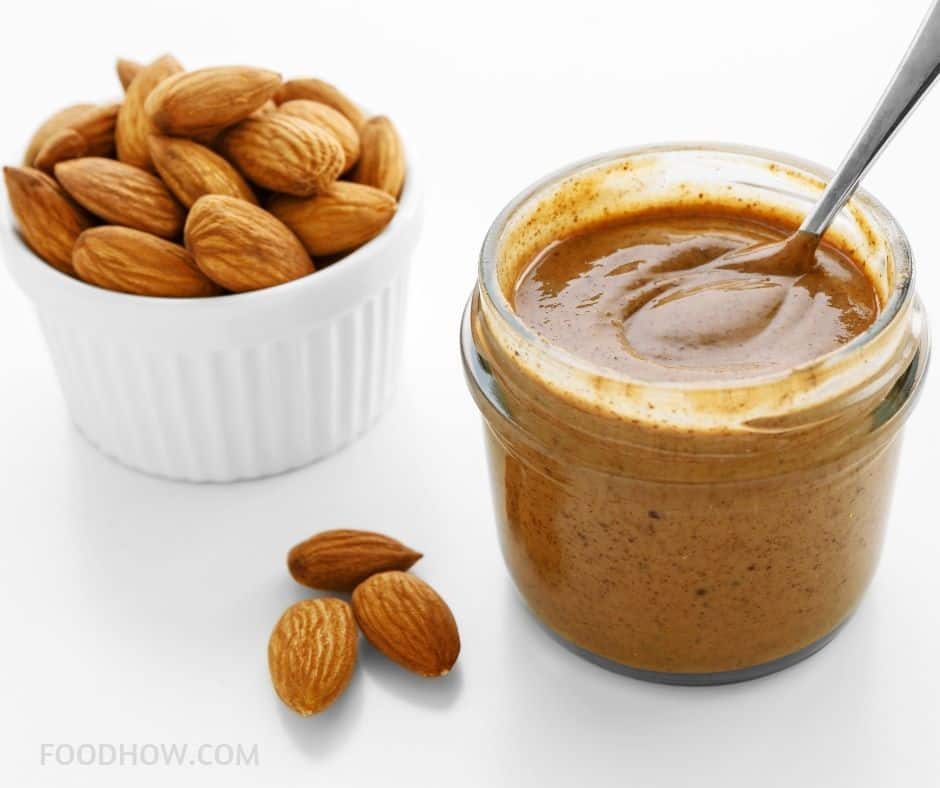
Almond Butter Nutrition Facts Per 100 Grams
- 614 Calories
- 56 Grams of Fat
- 4.2 Grams of Saturated Fat
- 21 Grams of Protein
- 19 Grams of Carbohydrates
How Tahini Compares To Almond Butter
Almonds are nutrient-dense and very healthy. You’ll find plenty of selenium, folic acid, potassium, and antioxidants in almonds. You’ll also get a lot of fiber too, which helps strengthen your digestive system and allows you to feel full faster.
Almond butter is an incredible source of vitamin E. It prevents damage to the body’s cells, and it is a good source of other important nutrients like calcium, vitamin E, magnesium, and potassium, fiber.
Almond butter is just a bit healthier than peanuts, but peanut butter offers more protein than almond butter. Still, almond has slightly higher calcium and iron content, which are important nutrients people need more in their diets.
People who are worried about aflatoxins or allergies usually go for almond butter. However, Tahini gets even better. It contains many more nutrients that are beneficial to the body. These benefits range from heart health to hormonal balance, skin, and bone health. In addition to this, it is gluten-free.
Though very few people are allergic to almonds, Tahini has even fewer people who are allergic to it. This is great, but a downside is the high fat content and calories it has. Like with any nut butter, it’s best to consume it in moderation.
Try This Organic White Almond Butter Below:
Tip: Mix 1 to 2 tbsp of almond butter with a bowl of oatmeal.
2. Peanut Butter

Peanut Butter Nutrition Facts Per 100 Grams
- 588 Calories
- 50 Grams of Fat
- 10 Grams of Saturated Fat
- 25 Grams of Protein
- 20 Grams of Carbohydrates
Peanut butter is rich in protein and mono-unsaturated fat. It provides plenty of vitamin E, copper, and manganese. It’s also an excellent source of niacin (a B vitamin used to make stress hormones in the adrenal glands).
Peanut butter and Tahini have similar nutritional benefits. They are both high in healthy fats and have a small amount of sugar. Though peanut butter may have a little more protein, Tahini is a lot safer for people who have nut allergies.
Peanuts are likely to grow the aflatoxin mold that is linked to liver cancer and are produced by a fungus that often grows on peanut crops. Still, they are unlikely to affect your health except when the peanut butter is consumed in large amounts on a regular basis.
On the other hand, Tahini has 20% protein, greater B vitamins, and minerals, which are more digestible than both almond and peanut butter. Peanut butter is sometimes known to cause intestinal problems because it contains aflatoxin. It is also very fattening, while Tahini actually helps to regulate metabolism.
If you have nut allergies, then sesame seed butter is a suitable alternative. You’ll find plenty of minerals in Tahini, including potassium, Omega-6 fatty acids, and calcium. There is also a lot of iron, which reduces your chances of getting anemia. Tahini gives you still a fair amount of protein, just like peanut butter.
If you really love peanut butter then this is a deal not to be missed:
Recipe: Mix 2 tbsp of peanut butter with a smoothie of your choice.
3. Cashew Butter
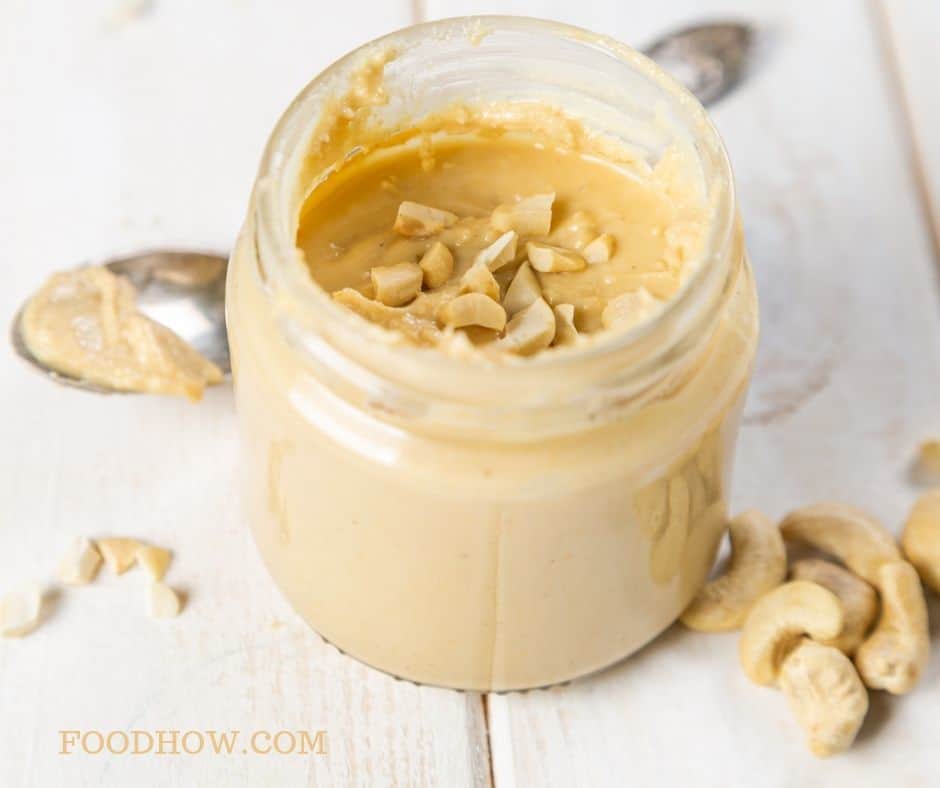
Cashew Butter Nutrition Facts Per 100 Grams
- 587 Calories
- 49 Grams of Fat
- 10 Grams of Saturated Fat
- 18 Grams of Protein
- 28 Grams of Carbohydrates
Cashew butter contains some powerful nutrients like manganese, copper, zinc, and magnesium. These nutrients promote the strength of your bones. According to research, your triglyceride levels can be reduced by consuming cashews.
If you haven’t tried cashew butter yet, then this one below is absolutely the best. It is 100% organic, pure cashews, no other ingredients, and no additives of any kind.
Tip: Cashew butter makes a great strawberry dip.
4. Hazelnut Butter
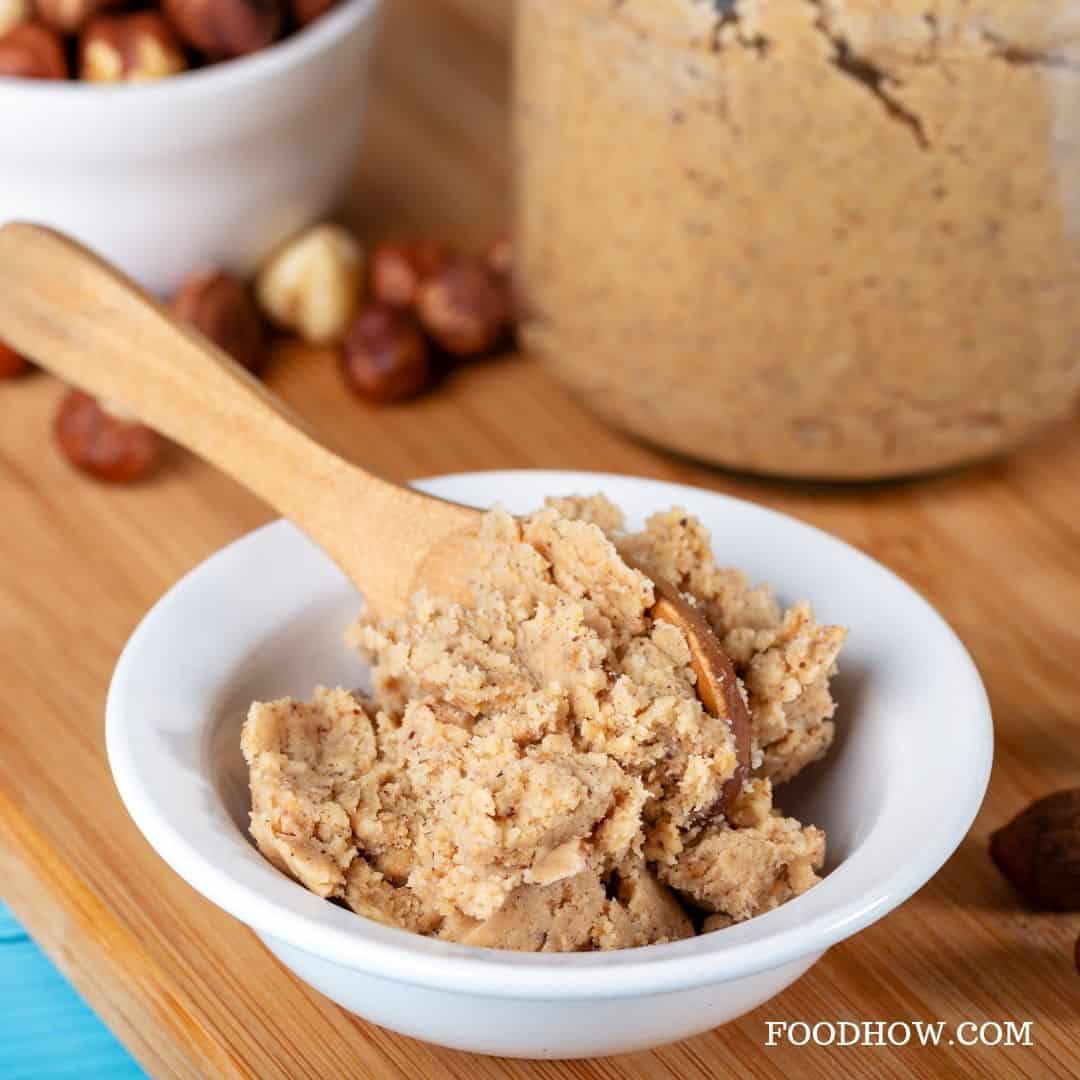
Hazelnut Butter Nutrition Facts Per 100 Grams
- 588 Calories
- 50 Grams of Fat
- 10 Grams of Saturated Fat
- 25 Grams of Protein
- 20 Grams of Carbohydrates
Hazelnut butter has a lot of key nutrients like manganese, copper, and Vitamin E. There is also a great amount of fiber and B vitamins in hazelnut. This helps stimulate the immune system and the functionality of the brain.
Also, if you want to reduce sodium in your body, then consume raw hazelnut butter because it doesn’t have any sodium in it.
One of the best hazelnut butter to try:
Tip: Mix 1 tbsp of agave syrup with 2 tbsp of hazelnut butter. Put on pancakes.
Conclusion
As you can see, there is no clear winner really. There are a lot of benefits that you’ll receive from consuming seed and nut butter.
Tahini has slight advantages when it comes to overall nutrient content, but Almond butter is difficult to beat on taste.
So if you are not restricted by any allergies or have a strong taste preference, it would be a good idea to add both of them to your diet, which is precisely what I have done.
However, you must be vigilant when shopping at the store for a nut or seed butter. Some brands will mix a lot of unhealthy ingredients with butter, such as preservatives, sugars, salts, and hydrogenated oils.
For this reason, try to find organic products that have all-natural ingredients or very few ingredients added.
Have you decided to try Tahini, or maybe you prefer Almond Butter? Tell us what you think.





